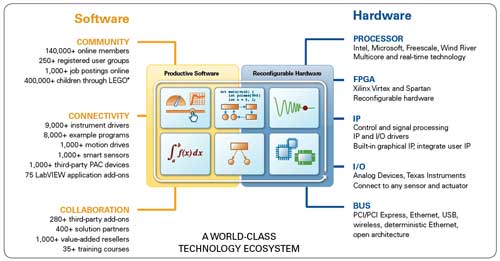Latest News
December 1, 2011
By Norma Dorst
Editor’s note: This commentary was sponsored as part of DE’s Visionary Voices section.
Graphical system design is a platform-based approach to accelerate the development of any system that needs measurement and control. With it, you shorten the development process by using your knowledge of the platform to map any application requirement through a consistent API to deploy to the specific hardware target you need. This flexible, integrated software and hardware platform speeds the development of test, control, monitoring, embedded and measurement systems. It helps you more easily integrate changing technology and requirements over time while providing better productivity, higher performance, and lower costs than point solutions.
Key Elements to a Flexible System Platform
Any system that needs measurement and control can be broken down into key elements: measurement and control I/O, mathematical models and analysis, user or operator interfaces, processing, communications, and other technologies. To design and implement these systems, you need ways to describe system functionality in software: models of computation, representations of system timing, etc. You can combine these elements with the physical hardware platforms to make the functional system.

Graphical system design using the NI platform is supported by a growing
ecosystem of IP, technology, and applications.
NI LabVIEW system design software integrates system elements in a way that abstracts complexity to help you focus on meeting your application challenges rather than on system integration. It offers the ability to visualize multiple ways to program system functionality, using the best model of computation for the behavior that you need. With LabVIEW, you also gain access to thousands of built-in and community-developed libraries that integrate mathematical models, I/O hardware, and any other components you need to build a system.
Abstracting Complexity
LabVIEW abstracts the complexity of commercial technologies like FPGAs. An intuitive loop and icons replace thousands of lines of equivalent VHDL code. Without this approach, you have to learn technology-specific development tools or interface with specialists. By leveraging commercial technology more easily with graphical system design, you gain the performance and cost benefits of those technologies faster.
Integrating Diverse Requirements
Graphical system design also helps you meet diverse requirements faster than traditional methods. To visualize system functionality, different system components may need different methods, or models of computation, to best describe them. LabVIEW incorporates multiple models of computation to describe various components of your system in the way that best fits your need.
Finally, LabVIEW VIs compile through the desktop, real-time, FPGA, and DSP compile tools to multiple hardware targets. The targets share common architecture elements that make it easier to scale from high-performance and high-power requirements to lower cost, smaller footprint systems.
Architectures Optimized for Graphical System Design
Graphical system design includes both software and hardware as part of a design and implementation platform. Often in the implementation phase of prototypes or end systems, IP from design tools needs translation, slowing down development. Graphical system design helps you overcome challenges by integrating software with off-the-shelf hardware. This approach takes a comprehensive view of the system for the ultimate purpose.
Platform Ecosystem Drives Innovation
When using graphical system design, you can leverage the work of other engineers in the platform ecosystem by accessing thousands of software and hardware components to efficiently solve your application. You gain a flexible platform that abstracts complexity and tightly integrates software and hardware to shorten the most time-consuming portions of the design process. With LabVIEW, reconfigurable hardware, and an ecosystem of IP, you can leverage thousands of person-years of work to help you innovate and invent—fast.
Norma Dorst is Corporate Marketing Manager, National Instruments.
Subscribe to our FREE magazine, FREE email newsletters or both!
Latest News
About the Author
DE’s editors contribute news and new product announcements to Digital Engineering.
Press releases may be sent to them via [email protected].






